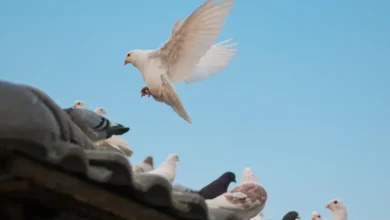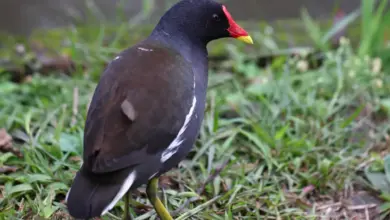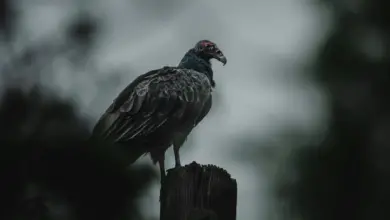The Speckled Mousebirds (Colius striatus) – also known as Bar-breasted Mousebirds, or Bar-breasted or Speckled Colies – are the most widespread and the largest members of the African mousebird family.
This family was named for their soft fluffy, mousy grey-brown plumage and long, thin tails, and their mouse-like habit of scurrying around in brush as they search for food.
[ez-toc]
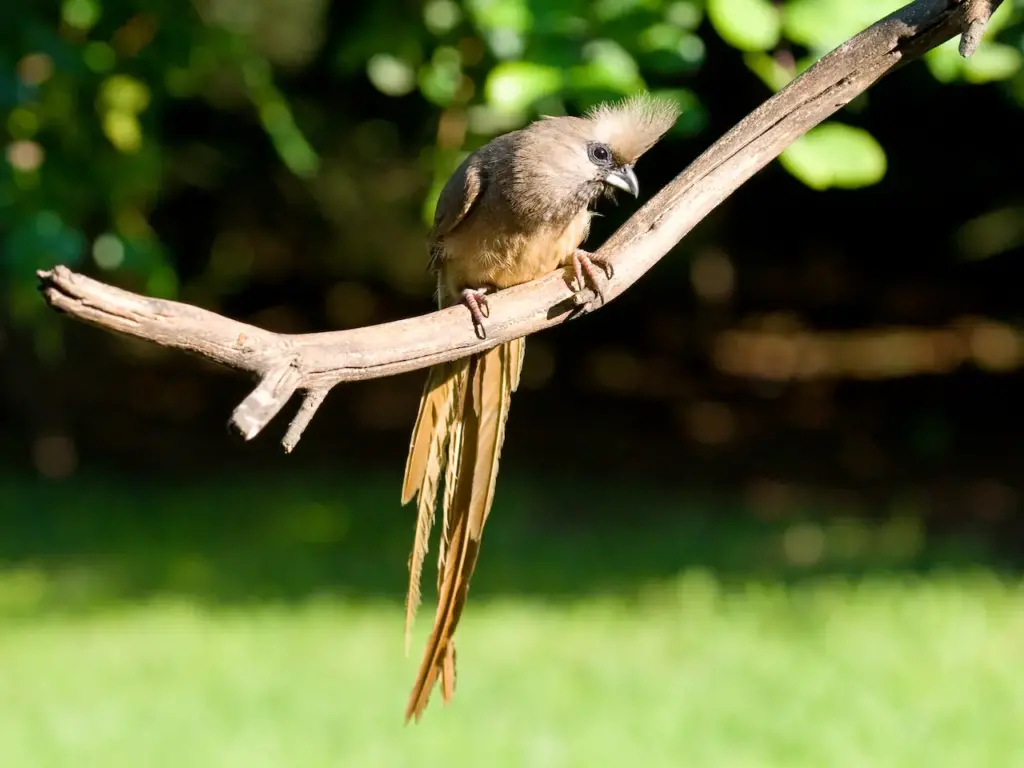
These highly social birds are often seen in noisy flocks foraging or dust bathing together or engaging in mutual preening.
Due to their low-calorie, fruit-based diet, these birds go into torpor (temporary or semi-hibernation) on cold nights to conserve energy. During this time, their heart rate slows down, their body temperature decreases and they remain in a so-called “suspended animation” until it is time for them to wake up and feed again.
The only other groups of birds known to go into temporary hibernation are hummingbirds and nighthawks. These mousebirds generally roost in tight groups of 20 or more birds to prevent heat loss and also to deter nocturnal predators.
Distribution / Habitat
Speckled Mousebirds occur naturally in Africa – from Cameroon east through the Central African Republic, southern Sudan, Ethiopia, Eritrea and south Somalia, south through Kenya (except for the arid northern and eastern lowland areas of Kenya), eastern Africa to southern South Africa.
They are usually found in open bush and woodland areas. They are also common in urban areas frequenting gardens and orchards.
They are also popular in the pet cage trade.
Subspecies and Ranges:
Three different species groups have been identified. Within these groups, races often intergrade. Species from different groups don’t appear to hybridize even in contact areas. It is likely that some will eventually be separated.
The “Striatus Group”:
Occurs in the southern part of the range. Contains the following races:
- South-African Speckled Mousebird (Colius striatus striatus – Gmelin, 1789) – Nominate form
- Range: Southern parts of South Africa, specifically from the Cape Province east to the Great Kei river.
- Natal Speckled Mousebird (Colius striatus minor – Cabanis, 1876)
- Range: Eastern South Africa, including most of Transvaal and Natal, as well as Swaziland and extreme southern Mozambique to the north.
- Speckled Mousebird (integralis) (Colius striatus integralis – Clancey, 1957) – Sometimes lumped together with ssp. minor
- Range: Southeastern Zimbabwe and southern Mozambique south to the Delagoa Bay) and northeastern South Africa, including the eastern parts of Transvaal and northeastern Zululand.
- Speckled Mousebird (rhodesiae) (Colius striatus rhodesiae – Grant and Mackworth-Praed, 1938)
- Range: Highlands of eastern Zimbabwe and adjacent Mozambique in the provinces of Manica and Sofala.
- Speckled Mousebird (simulans) (Colius striatus simulans – Clancey, 1979)
- Range: Extreme southern Malawi and central Mozambique, where they are found in the Zambezi River Valley).
The “Nigricollis Group”:
Found in the northwestern part of the range. Comprises the following races:
- Congo Speckled Mousebird (Colius striatus nigricollis – Vieillot, 1817)
- Range: Northwest Ghana (Mole National Park), and southeastern Nigeria – east of the Niger River and the Jos Plateau – east to southwestern Central African Republic and south to western Angola, where they are found from Cabinda south to northern Namibe, and southwestern areas of the Democratic Republic of the Congo.
- Uele Speckled Mousebird (Colius striatus leucophthalmus – Chapin, 1921)
- Range: Southeastern Central African Republic, northeastern parts of the Democratic Republic of the Congo Republic of the Congo, and southwestern Sudan.
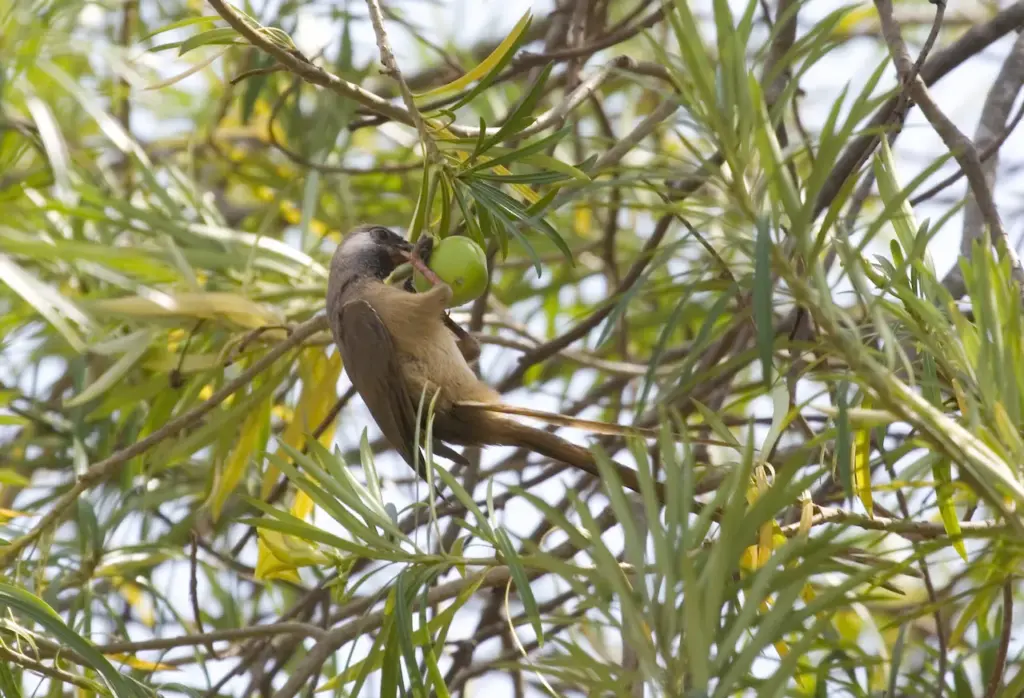
The “Leucotis Group”:
Found in the eastern part of the range. Comprises the following races:
- East Coast Speckled Mousebird (Colius striatus affinis – Shelley, 1885)
- Range: Coastal areas of eastern Tanzania.
- Berlepsch’s Speckled Mousebird (Colius striatus berlepschi) Hartert, 1899) – Sometimes lumped together with ssp. affinis
- Range: Southern Tanzania, northeastern parts of the Democratic Republic of the Congo, and Malawi.
- Speckled Mousebird (mombassicus) (Colius striatus mombassicus – Someren, 1919)
- Range: Southern Somalia, coastal areas of eastern Kenya and northeastern Tanzania.
- Speckled Mousebird (cinerascens) (Colius striatus cinerascens – Neumann, 1900)
- Range: North-central, western and central Tanzania
- Populations found around Mt Kilimanjaro in northern Tanzania were previously separated as race marangu. However, they are now believed to be a hybrid population and are usually included with ssp, cinerascens
- Uganda Speckled Mousebird (Colius striatus kikuyensis – Someren, 1919)
- Range: Central Kenya Highlands and nearby northern Tanzania.
- Populations with reddish-brown back and chest from Mount Marsabit and Chyulu Hills in Kenya are sometimes separated respectively as races marsabit and chyulu, now generally merged with kikuyensis;
- Lake Kivu Spekcled Mousebird (Colius striatus kiwuensis – Reichenow, 1908)
- Range: Between lakes Albert and Tanganyika, in eastern areas of the Democratic Republic of the Congo, western Uganda, Rwanda and Burundi.
- [Speckled Mousebird (ugandensis) (Colius striatus ugandensis – van Someren, 1919)] – Mostly lumped together with ssp. kiwuensis
- Range: Southern Uganda, western Kenya and extreme northwestern Tanzania.
- Speckled Mousebird (congicus) (Colius striatus congicus – Reichenow, 1923)
- Range: Southeastern areas of the Democratic Republic of the Congo, from Kasai Oriental east to lake Tanganyika), and south to northeastern Angola and northwestern Zambia.
- [Speckled Mousebird (lungae) (Colius striatus lungae – White, 1947 )] – Mostly considered invalid. Typically included in ssp. congicus described above.
- Range: Northwestern Zambia
- Upper Nile Speckled Mousebird (Colius striatus jebelensis – Mearns, 1915)
- Range: Southern Sudan, extreme north-eastern areas of the Democratic Republic of the Congo and northern Uganda.
- Abyssinian Speckled Mousebird (Colius striatus leucotis – Rüppell, 1839)
- Range: Eastern Sudan, where they occur in the state of Blue Nile, and western Ethiopia.
- [Speckled Mousebird (erlangeri) (Colius striatus erlangeri – Zedlitz, 1910 )] – Mostly included with ssp. leucotis.
- Range: Southeastern Sudan and central and southwestern Ethiopia.
- Somaliland Speckled Mousebird (Colius striatus hilgerti – Zedlitz, 1910)
- Range: Northeastern Ethiopia, Djibouti and extreme northwestern Somalia.
Description
Size
The Speckled Mousebird measures about 14 inches (35 cm) in length of which half of the length is comprised by the tail. The average weight is 2 oz or 57 grams.
Plumage Details / Adults
The back, head and crest are mostly brownish to greyish brown (“mousy brown”). The forehead, lores (area between the bill and the eye) and the area around each eye is dark brown to blackish. The plumage below is a paler brown, except for a dark grey throat and fine barring on the neck and chest.
The underwing feathers are brown with greyish-brown tips.
There is fine barring on the mantle and rump that can only be seen at close range.
Other Physical Details
It has a prominent head crest that is the same color as the rest of the head and back.
The bill is strongly down-curved. The upper bill is blackish and the lower bill is flesh-colored or whitish.
The legs and feet are dark pinkish-red. All members of the mousebird family have strong feet that are relatively large for their body size and are widely spaced. Unlike other birds, they are able to rotate all four toes to face forward allowing them to feed upside down, hold food with their feet, and perch with their legs positioned at strange angles.
Gender ID
Males and females look alike.
Similar Species
They are most commonly confused with the less common White-headed Mousebird, particularly in bright light when their plumage looks paler. However, the White-headed Mousebird has a grey orbital (eye) patch, which is lacking in the Speckled Mousebird, and has a white crown (brownish in the Speckled).
Also, the Speckled Mousebird has a flesh-colored lower bill and blackish upper bill. This 2-tone bill is unique amongst the mousebird family.
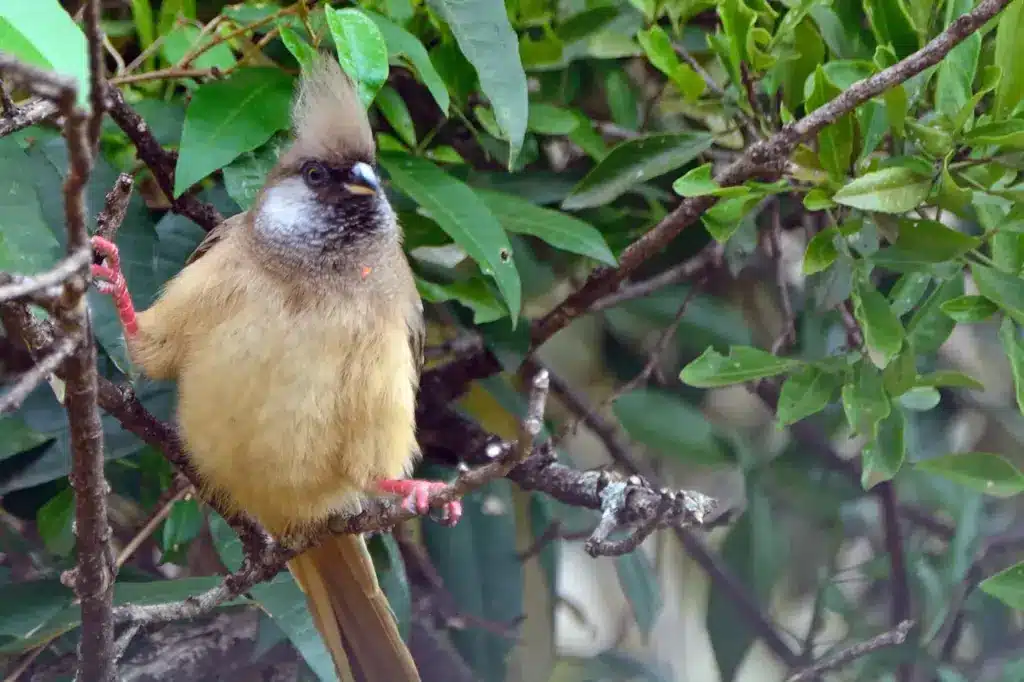
Diet / Feeding
Like all members of the mousebird family, Speckled Mousebirds mostly feed on fruits, berries, leaves, buds, flowers, nectar and seeds. They may also eat soil and swallow pebbles to assist in grinding up vegetation to facilitate digestion.
Breeding / Nesting
Most birds are monogamous (one mate), others are polygynous (several mates). However, with these birds both monogamous and polygynous pairings have been observed. Several females may lay their eggs into the same nest and share incubation and chick-rearing duties. Males also help with incubating the eggs and raising the chicks.
Speckled Mousebirds may breed throughout the year. Their nests are relatively large for birds of their size. Both the male and the female construct the nest out of pits of vegetation and animal material, as well as items found in their environment (such as cloth and paper).
Females can lay up to 7 eggs in a nest, but the average clutch consists of 3 – 4. The eggs are incubated for about 14 days.
Parents, as well as helpers (often the young from previous seasons) assist in raising the chicks, which usually leave the nest when they are 17 – 18 days old. They are generally independent when they are about one month old.
Calls / Vocalizations / Sounds
Speckled Mousebirds are noisy with warbling tsu-tsu vocalizations or tisk-tisk alarm calls made in flight.
